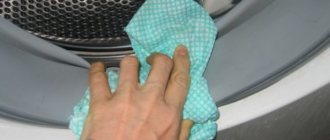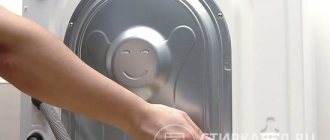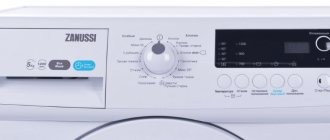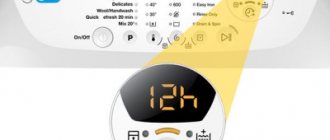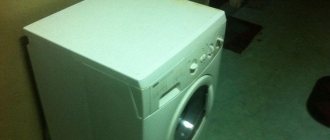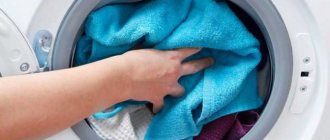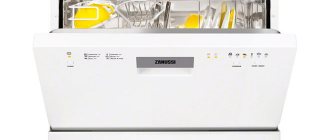Zanussi is one of the world's most famous manufacturers of household appliances. On sale you can find a large number of various models of washing machines of this brand. For installation in small spaces, compact units with vertical loading are usually chosen - for example, models ZWQ 61225, ZWP 582, ZWQ 61216. What are the advantages and disadvantages of such equipment? We will answer this and many other pressing questions in this article.
Top-loading washing machine is a compact appliance that will help save space
Loading washing powder
Washing powder is loaded into a special powder tray, which has three compartments:
- the left compartment is for the main wash;
- right – for preliminary;
- medium - for air conditioning.
This distribution of compartments is typical for almost all brands of washing machines. On Zanussi machines, on the front panel of the tray there is a reminder about the purpose of its compartments. For other models, you can always check by looking at the user manual, which includes a complete guide to operating the machine.
When adding powder, you should follow the dosage. It is usually indicated on the packaging.
Some are sure that the more powder, the higher the quality of washing. This is a misconception, leading to the fact that excess powder is poorly rinsed, and then becomes a source of allergic diseases.
Flaws
Any appliance has its pros and cons, and the Zanussi top-loading washing machine is no exception. The choice of models is not as wide as compared to front-facing analogues. This is explained simply: cars with the usual round hatches located on the front wall are more popular. Consequently, manufacturers are investing more time and money in expanding the model range of just such equipment.
From a purely practical point of view, such washing machines also have a disadvantage - you cannot place household items, laundry baskets or detergents on the top cover. Due to the upper location of the loading hatch, such a unit is difficult to integrate into a built-in kitchen set.
Error codes for Zanussi washing machines
The advantage of Zanussi washing machines is their ability to inform the user about the cause of the malfunction. To determine the breakdown, simply decipher the code shown on the display.
- E11 – no liquid entering the tank;
- E13 – liquid gets into the bottom of the washing machine;
- E21 – water does not leave the tank at the end of the mode;
- E23 – the triac has burned out (a semiconductor part responsible for the state of the pump);
- E24 – the track from the triac of the washing machine is damaged;
- E31 – machine pressure switch is faulty;
- E32 – problem with the gauge sensor responsible for pressure;
- E33 – malfunctions in the liquid level sensors of the washing machine;
- E34 – discrepancy between the pressure switch and the anti-boiling indicator;
- E35 – excess water level in the washing machine;
- E38 – pressure difference not recorded;
- E40 – the washing machine hatch is open;
- E42 – the blocker needs to be replaced;
- E54 – the contacts of the washing machine relay are stuck together;
- E55 - problem with the electrical connection of the engine;
- E57 - the current of the washing machine system exceeds 15A;
- E61 – heating does not occur at full strength;
- E62 – overheating during machine operation;
- E68 – grounding in the heating element circuit;
- E69 – a problem with the heating element of the washing machine;
- E71 – problems with the resistance level of the machine’s temperature sensor;
- E74 – the location of the machine’s temperature sensor does not correspond to the norm;
- E84 – the recirculation pump is not recognized;
- E85 - problems in the electronic unit of the car;
- E91 – there is no connection between the user interface and the main unit;
- E92 – failure in the configuration of the washing machine;
- E5C – machine voltage is too high;
- EC1 – filling valve is blocked;
- EC2 – failure of the sensor that detects turbidity;
- E5F – inverter board error;
- EF1 – the machine drains for too long;
- EF1 – absence of flow signal;
- EA3 – DSP does not fix the electric motor pulley;
- E5F – engine does not start;
- E84 – recirculation pump is not recognized;
- E9A – problems in the car’s sound supply system;
- EB1, EH1 – frequency in the power supply network has been exceeded;
- EF3 – there is a leak inside the washing machine;
- E5F – configuration parameters of the FCV control board are violated;
- EF5 – spinning clothes in the washing machine drum does not start.
This section discussed only some of the possible errors that occur when operating Zanussi washing machines. A wider list with a detailed description of the causes of problems and ways to deal with them is in the instructions supplied with the product.
Characteristics
| Maximum load | 5.5 kg |
| Max. spin speed | 850 rpm |
| Control type | mechanical/electronic |
| Indication of program steps | Yes |
| Leak protection | add. option |
Instructions for Zanussi ZWP581
pdf 1.8 Mb
Download certificate of conformity
pdf 162.7 Kb
Full information about the product, manufacturer, configuration, technical characteristics and functions is contained in the technical documentation.
Selecting a washing mode
The operating mode is selected either by pressing the corresponding button or by rotating the switch whose arrow is directed to the selected mode. Some models, such as Zanussi, have both types of control.
The washing machine has different operating modes, depending on the type of fabric and washing intensity:
- cotton;
- synthetics;
- wool;
- everyday washing;
- quick wash;
- gentle wash;
- baby clothes.
General tips for working with Zanussi washing machines
Zanussi washing machines are durable and reliable. Their main advantages are the ability to work in accelerated or silent mode, the presence of programs that provide delicate cleaning of children's things, energy saving and disinfection. The company also provided consumers with the ability to quickly determine the cause of problems using codes displayed on the display.
The causes of breakdowns and emergency situations are often non-compliance with the rules and recommendations specified in the instructions, incorrect installation or frequent power failures.
Starting the washing process
The machine is turned on by pressing the “ON” button. The cycle is started by pressing the “START” button. When the wash starts, the indicator shows the time before it will end.
Important! Many modern models, such as Zanussi, have a delayed start option. This means that you yourself can determine when to turn on the machine by specifying a specific time.
If you prepare the machine with laundry, set the delayed start mode, setting the start, for example, at 5 o’clock in the morning, you can easily forget about it. The device can turn on at the appointed time and carry out the specified program. And all you need to do is take out your clean laundry in the morning.
Important! By doing laundry at night, you will significantly save on the difference between day and night electricity tariffs
Advantages
There is an opinion that front-loading washing machines are more reliable than vertical ones. But this is just a stereotype - the location of the loading hatch in no way affects the quality of washing and the durability of the unit. If you plan to install the machine in a cramped bathroom or small closet, then feel free to choose a top-loading model.
Loading of laundry is carried out through the top hatch
The main advantages of such equipment:
- Small dimensions. The standard width of the unit is 60 cm, depth – 40 cm, height – up to 90 cm.
- Optimal loading volumes. According to this indicator, the units do not differ from their front-loading counterparts.
- Ease of use. Due to the fact that the hatch is located on top, during the washing process you can pause the program and add laundry to the drum.
- Safety for children. The control panel is located on the lid, making it difficult for small children to reach and press buttons. In addition, a small child will not be able to attempt to open the drum hatch.
Zanussi top loading washing machine drum
Repair cost
The final cost of repair depends on the type of problem with your washer. It is determined by the technician during diagnostics. But now you can get acquainted with the approximate cost of repair work. For convenience, the information is divided into 2 blocks - by the name of the work and depending on the symptoms of the breakdown.
| Symptoms of a problem | Repair time | Price ** |
| Expert visit and diagnostics* | 5-10 minutes | 0 rub.* |
| No drain | from 20 minutes | from 1000 rub. |
| No water heating | 30-60 minutes | from 1800 rub. |
| Lights are flashing | from 20 minutes | from 1300 rub. |
| Doesn't start, power light is off | from 20 minutes | from 1400 rub |
| Doesn't spin the drum | from 40 minutes | from 1100 rub. |
| Water does not fill | from 30 minutes | from 1200 rub |
| It makes noise and creaks | from 40 minutes | from 1500 rub. |
| Vibrates strongly | from 40 minutes | from 1600 rub. |
| Kicks out traffic jams | 30-60 minutes | from 1800 rub. |
| Water is leaking from under the machine | from 30 minutes | from 1200 rub. |
| No spin | from 40 minutes | from 1100 rub. |
| The hatch of the car does not open | from 30 minutes | from 1700 rub. |
| The hatch of the car does not close | from 30 minutes | from 1700 rub. |
| Rinse mode does not start | from 30 minutes | from 1900 rub. |
* If you refuse repairs, you must pay 400 rubles. for calling the master
** The cost of repairs is indicated FOR WORK ONLY, the price of spare parts is not included in the prices
Basic programs of a Zanussi washing machine
Zanussi washing machines are characterized by a wide range of modes. Usually they are all spelled out in the instructions, but it’s still worth taking a closer look at the features of the basic programs, including:
- Cotton. For white and colored cotton items: clothes, towels, bed linen and underwear. Heating occurs to 60-95°C, things go through three stages of cleansing, and the process itself takes from 2 to 3 hours.
- Synthetics. Products made from this fabric: linen, tablecloths, napkins, blouses, require low temperatures - 30-40°C and can be washed in an hour and a half.
- Handwash. Designed for very delicate and thin fabrics and suitable for knitted materials, tulle, organza, satin. Warming up is minimal and there is no spin.
- Daily wash. Refreshes laundry in half an hour and provides a high speed of rotation.
- Removing stains. Aimed at effective removal of contaminants and involves the use of a stain remover.
- Intensive For removing tough stains and dirt. Maximum heating temperatures are used.
- Silk and wool. The most gentle and gentle modes with a minimum number of revolutions and no spin.
- Energy saving. Addition to the Zanussi basic mode. Reduces the heating rate of the washing machine and saves electricity.
- Children's room. A large amount of water is used when rinsing.
- Shoes. Cleaning occurs at a temperature of 40 °C, goes through three rinsing stages and is distinguished by a large number of revolutions.
- Night mode. It happens quietly and with minimal energy consumption. The spin is turned on manually as indicated in the instructions.
- Disinfection. Used to eliminate germs, mites and allergens.
- Blankets. The mode is designed for cleaning products with fillers.
- Additional rinse. It is an addition to basic washing machine programs and ensures better removal of detergent residues.
- Jeans. Designed for denim and fights fading and fading.
- Forced drain mode. Typically used for overnight washing.
